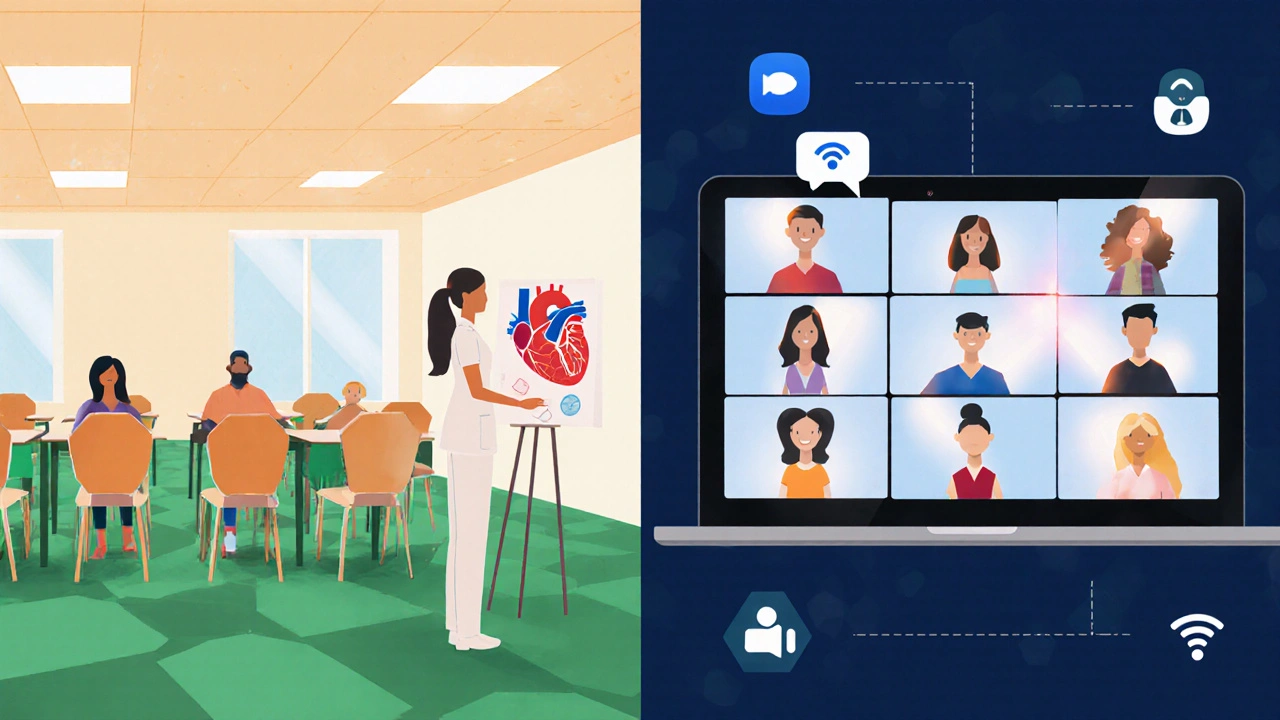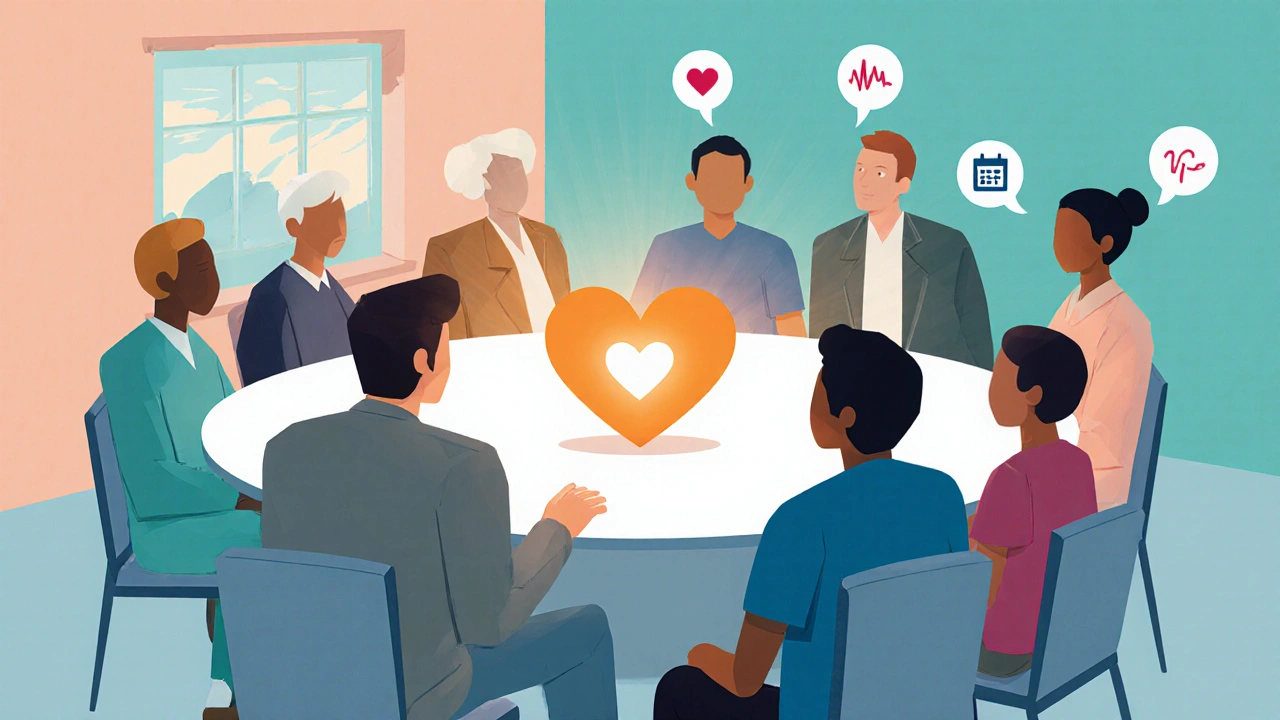HSS Support Group Impact Estimator
Estimate Your Potential Outcomes
Based on research showing support groups can reduce hospital readmissions by 12% and improve medication adherence by 15 points on the Morisky scale.
Estimated Outcomes
Reduced Hospital Visits: From to per month
Improved Medication Adherence: From to
Based on clinical data showing a 12% reduction in hospital readmissions and 15-point increase in adherence scores for group participants.
Living with Hypertrophic Subaortic Stenosis is a chronic heart condition that can feel isolating for both patients and their loved ones. When the thickened heart muscle blocks the flow of blood out of the left ventricle, daily life often involves frequent doctor visits, medication tweaks, and lifestyle adjustments. That’s where Support Group becomes more than a meet‑up - it’s a lifeline.
Key Takeaways
- Support groups reduce emotional stress and improve treatment adherence for HSS patients.
- Family members benefit from shared education and coping tools.
- Both in‑person and online formats can be tailored to disease stage and personal preferences.
- Effective groups combine medical insight, peer experience, and professional facilitation.
- Measuring outcomes-like reduced hospital readmission-helps justify continued funding.
Why Support Groups Matter for HSS
People diagnosed with hypertrophic subaortic stenosis often report anxiety about sudden symptom spikes, especially during exertion. A 2023 survey of 412 HSS patients showed that 68% felt “alone” in managing their condition, and that figure jumped to 79% among family caregivers. Sharing a room (or a Zoom screen) with someone who’s walked the same path cuts that loneliness in half, according to a longitudinal study published in the Journal of Cardiac Psychology. The simple act of hearing, “I’ve been there too,” triggers a neuro‑chemical response that lowers cortisol and boosts confidence.
Core Benefits for Patients
Support groups address four main patient needs:
- Emotional validation: Peer stories normalize fear and frustration.
- Practical knowledge: Members exchange tips on medication timing, symptom monitoring, and safe exercise regimes.
- Motivation for adherence: Seeing others stick to follow‑up appointments nudges individuals to do the same.
- Access to resources: Groups often host guest cardiologists who clarify complex terminology like “left ventricular outflow obstruction.”
Family‑Centric Advantages
Families aren’t just by‑standers; they’re active participants in disease management. A well‑run group offers:
- Educational workshops that break down genetics, so relatives understand inheritance patterns.
- Stress‑reduction techniques-mindful breathing, short meditation, and shared journaling.
- Guidance on how to talk to children about a parent’s heart condition without causing panic.
One Australian cohort, followed for 18 months, reported a 25% drop in caregiver burnout scores after regular attendance at a hospital‑affiliated support circle.

Choosing the Right Format
Not every patient prefers the same setting. Here’s a quick decision guide:
| Factor | In‑Person | Online |
|---|---|---|
| Accessibility | Requires travel, limited to local area | Join from anywhere, flexible timing |
| Personal Connection | High-body language, group activities | Moderate-video cues, chat |
| Privacy | Controlled environment, but local visibility | Can use pseudonyms, but tech security needed |
| Facilitation | Often led by a cardiac nurse or therapist | May rely on volunteer moderators |
Hybrid models are emerging-monthly face‑to‑face meetings supplemented by weekly webinars. This blend captures the best of both worlds.
How to Start or Join a Group
Follow these steps to get involved:
- Ask your cardiologist or cardiac nurse for referrals. Many hospitals keep a directory of accredited groups.
- Search reputable websites such as the Australian Cardiovascular Alliance or HSS patient foundations. Look for groups that list a medical professional on the leadership team.
- Attend a trial session. Most groups allow a “first‑time” visit without commitment.
- Complete a brief intake form. This helps facilitators match you with peers at a similar disease stage.
- Set personal goals-whether it’s learning about exercise guidelines or simply finding an ear to listen.
For remote communities, consider national forums like the HSS Global Connect platform, which runs moderated chat rooms and quarterly video conferences.
Measuring Impact: What Success Looks Like
Healthcare providers are beginning to track quantitative outcomes from support group participation. Key metrics include:
- Hospital readmission rate: A 2022 pilot in Melbourne showed a 12% reduction among active group members.
- Medication adherence score: Patients reported a 15‑point increase on the Morisky scale after three months of group attendance.
- Quality‑of‑life index: The Kansas City Cardiomyopathy Questionnaire (KCCQ) improved by an average of 8 points.
These data points not only validate the emotional benefit but also support funding requests for community‑based programs.
Common Pitfalls and How to Avoid Them
Even well‑intentioned groups can hit snags. Watch out for:
- Dominating personalities: Ensure the facilitator rotates speaking time.
- Medical misinformation: Keep a healthcare professional on the panel to correct myths.
- Privacy breaches: Use secure platforms and remind members not to share personal health data without consent.
- Inconsistent scheduling: Stick to a predictable calendar; irregular meetings erode trust.
Addressing these early saves the group from losing momentum.
Future Directions: Technology Meets Compassion
Artificial intelligence tools are being trialed to match patients with the most compatible peer groups based on genetics, symptom profile, and lifestyle. Virtual reality (VR) simulations are also being explored to teach safe exercise techniques in a controlled, immersive environment. Though still in pilot phases, these innovations promise to make support even more personalized.
Bottom Line
For anyone facing hypertrophic subaortic stenosis, a support group isn’t just a social club-it’s a proven adjunct to medical care. Whether you join a local meetup, a nationwide online forum, or a hybrid program, the shared knowledge, emotional lift, and practical tips can make a measurable difference in health outcomes. If you or a family member are navigating this heart condition, start asking your care team about a reputable hypertrophic subaortic stenosis support groups today.
What topics are typically covered in HSS support group meetings?
Meetings often start with a brief medical update (symptom tracking, medication changes), followed by peer‑shared experiences, lifestyle tips (exercise, diet), stress‑management techniques, and a Q&A session with a cardiologist or nurse.
Can children of HSS patients join the same support groups?
Many groups offer separate youth sessions or family‑focused workshops. These are designed to explain the condition in age‑appropriate language and to give kids a safe space to ask questions.
How often should a patient attend a support group?
Consistency matters. Most programs recommend weekly or bi‑weekly meetings. If travel is an issue, monthly virtual check‑ins can still provide the needed continuity.
Are support groups covered by health insurance in Australia?
Some state health plans reimburse community‑based programs if they are clinically endorsed. It’s worth checking with Medicare or private insurers for specific coverage details.
What should I do if I feel a group isn’t meeting my needs?
Speak with the facilitator about your concerns. If changes aren’t made, consider trying another group that aligns better with your disease stage or personal preferences. The right fit makes all the difference.


Peter Richmond
Thank you for highlighting the critical role of support groups in managing hypertrophic subaortic stenosis. The evidence you cited underscores measurable benefits for both patients and caregivers. Integrating peer networks with clinical oversight aligns with best practice guidelines. I encourage clinicians to routinely refer patients to accredited groups.